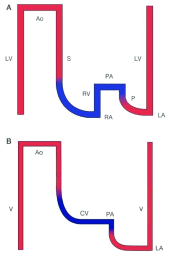State of the art of the Fontan strategy for treatment of univentricular heart disease
- PMID: 30002816
- PMCID: PMC6024235
- DOI: 10.12688/f1000research.13792.1
State of the art of the Fontan strategy for treatment of univentricular heart disease
Abstract
In patients with a functionally univentricular heart, the Fontan strategy achieves separation of the systemic and pulmonary circulation and reduction of ventricular volume overload. Contemporary modifications of surgical techniques have significantly improved survival. However, the resulting Fontan physiology is associated with high morbidity. In this review, we discuss the state of the art of the Fontan strategy by assessing survival and risk factors for mortality. Complications of the Fontan circulation, such as cardiac arrhythmia, thromboembolism, and protein-losing enteropathy, are discussed. Common surgical and catheter-based interventions following Fontan completion are outlined. We describe functional status measurements such as quality of life and developmental outcomes in the contemporary Fontan patient. The current role of drug therapy in the Fontan patient is explored. Furthermore, we assess the current use and outcomes of mechanical circulatory support in the Fontan circulation and novel surgical innovations. Despite large improvements in outcomes for contemporary Fontan patients, a large burden of disease exists in this patient population. Continued efforts to improve outcomes are warranted. Several remaining challenges in the Fontan field are outlined.
Keywords: Congenital heart defects; Fontan Procedure; Morbidity; Mortality; Pediatrics; Re-interventions; Single ventricle; Total cavopulmonary connection.
Conflict of interest statement
No competing interests were disclosed.No competing interests were disclosed.No competing interests were disclosed.
Figures



Similar articles
-
Current outcomes of the bi-directional cavopulmonary anastomosis in single ventricle patients: analysis of risk factors for morbidity and mortality, and suitability for Fontan completion.Cardiol Young. 2016 Feb;26(2):288-97. doi: 10.1017/S1047951115000153. Epub 2015 Feb 23. Cardiol Young. 2016. PMID: 25704070
-
Functionally univentricular heart and the fontan operation: lessons learned about patterns of practice and outcomes from the congenital heart surgery databases of the European association for cardio-thoracic surgery and the society of thoracic surgeons.World J Pediatr Congenit Heart Surg. 2013 Oct;4(4):349-55. doi: 10.1177/2150135113494228. World J Pediatr Congenit Heart Surg. 2013. PMID: 24327626
-
Evolution of the Fontan-Kreutzer procedure.Semin Thorac Cardiovasc Surg Pediatr Card Surg Annu. 2010;13(1):91-5. doi: 10.1053/j.pcsu.2010.01.006. Semin Thorac Cardiovasc Surg Pediatr Card Surg Annu. 2010. PMID: 20307869
-
The Pulmonary Circulation in the Single Ventricle Patient.Children (Basel). 2017 Aug 7;4(8):71. doi: 10.3390/children4080071. Children (Basel). 2017. PMID: 28783102 Free PMC article. Review.
-
Current readings: long-term management of patients undergoing successful pediatric cardiac surgery.Semin Thorac Cardiovasc Surg. 2014 Summer;26(2):132-44. doi: 10.1053/j.semtcvs.2014.08.002. Epub 2014 Aug 7. Semin Thorac Cardiovasc Surg. 2014. PMID: 25441004 Review.
Cited by
-
Total Thrombotic Occlusion of an Extracardiac Fontan Conduit in a Hemodynamically Stable Patient.JACC Case Rep. 2024 Aug 21;29(16):102421. doi: 10.1016/j.jaccas.2024.102421. eCollection 2024 Aug 21. JACC Case Rep. 2024. PMID: 39295804 Free PMC article.
-
A 12-week lifestyle intervention: effects on fatigue, fear, and nutritional status in children with a Fontan circulation.Front Pediatr. 2023 Nov 6;11:1154015. doi: 10.3389/fped.2023.1154015. eCollection 2023. Front Pediatr. 2023. PMID: 38027302 Free PMC article.
-
Cardiac Rehabilitation for Fontan Circulation Patients: A Systematic Review, and Meta-Analysis.Medicina (Kaunas). 2024 Nov 5;60(11):1817. doi: 10.3390/medicina60111817. Medicina (Kaunas). 2024. PMID: 39597002 Free PMC article.
-
Current Use of Pediatric Cardiac Magnetic Resonance Imaging in Brazil.Arq Bras Cardiol. 2021 Feb;116(2):305-312. doi: 10.36660/abc.20190860. Arq Bras Cardiol. 2021. PMID: 33656080 Free PMC article. English, Portuguese.
-
Relationship of Ventricular Morphology and Atrioventricular Valve Function to Long-Term Outcomes Following Fontan Procedures.J Am Coll Cardiol. 2020 Jul 28;76(4):419-431. doi: 10.1016/j.jacc.2020.05.059. J Am Coll Cardiol. 2020. PMID: 32703513 Free PMC article.
References
Publication types
LinkOut - more resources
Full Text Sources
Other Literature Sources

